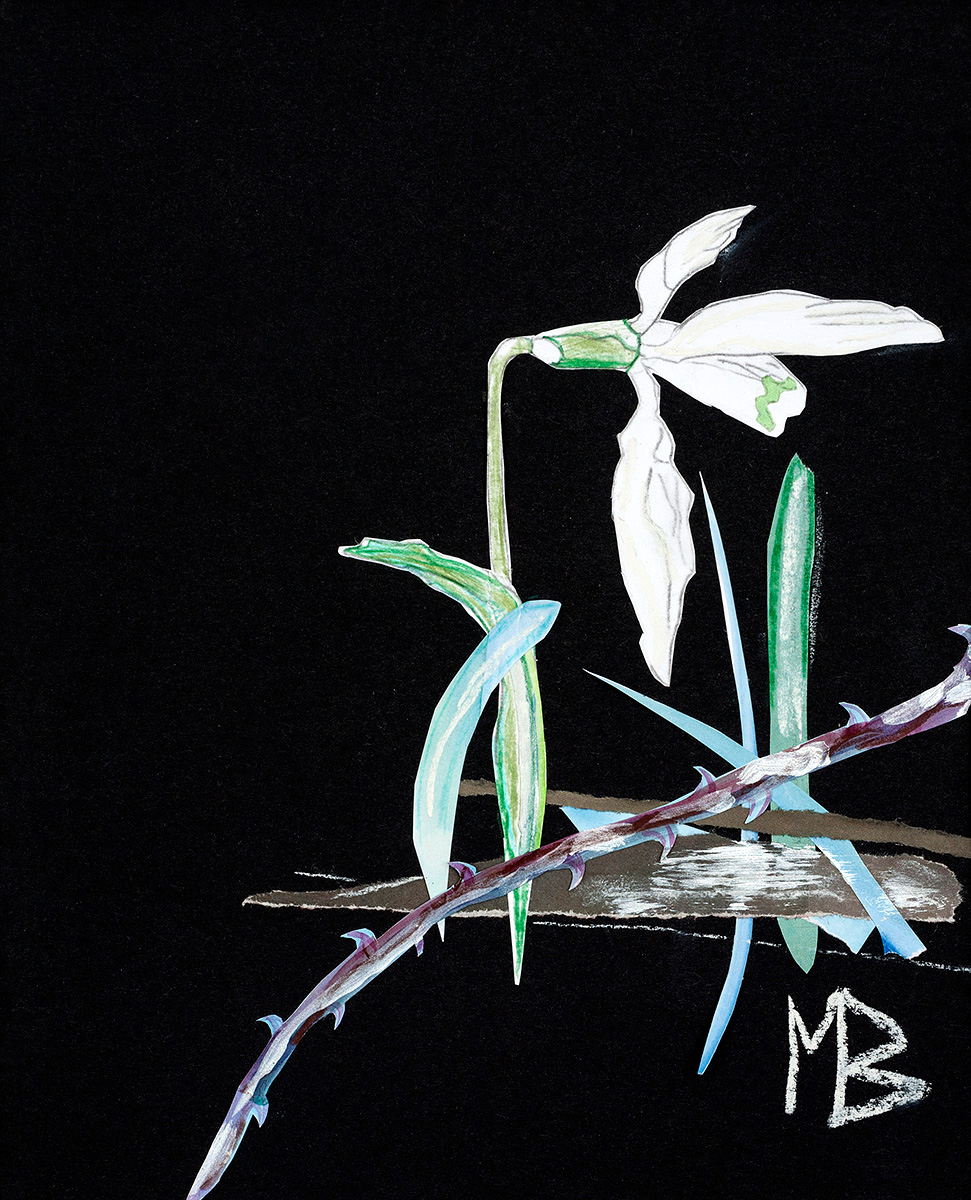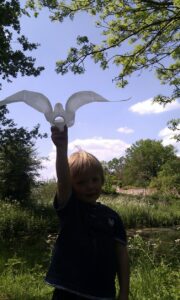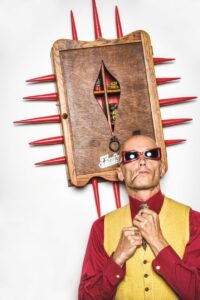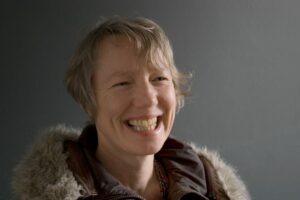
JANE BURN – POETRY AS HARD GRAFT, INSPIRATION, REACTION OR EXPERIMENT?
I interviewed poet & artist Jane Burn who won the Michael Marks Environmental Poet of the Year 2023-24 with A Thousand Miles from the Sea.


Mixed-media artist Mandy Burton specialises in working with environmental themes, using salvaged materials in her commissioned and personal work. I interviewed Mandy in two parts about her assemblage & installations, her creative work with young people, and her graphic story book for young children. Mandy, who was inspired by the early pioneers of Permaculture, has a passionate concern for sustainability and the environment.
In part one of the interview Mandy concentrates on her upbringing and community art projects.
Leslie: Can you tell the story, please, of how you became an environmental artist and what has gone into some of your most representative projects.
Mandy: I’ve always been captivated by the ‘web of life,’ and even as a child I liked drawing natural shapes, so my interests have fed into each other. Aged six, on my birthday, Dad showed me snowflakes through a magnifying glass; perhaps this triggered my fascination with structure? It made me wonder what lies behind the forms and patterns of things.

Dad was dyslexic and didn’t learn to write, left school at twelve but was clever and could make anything. Mum is bright too, but they didn’t discover she needed glasses until she was fourteen, and was so shy and quiet she never told anyone! So she missed a lot of education. My parents didn’t have the skills to encourage me academically, but what they did give me, was freedom, love and trust.
Raised in a small, village community where we were ‘incomers’, I was a loner who roamed the landscape. Around our house, I hid from other kids inside ancient hedges ‘laid’ years ago, now twisted and hollow, used by sheep, cows and me, as places of refuge. Like natural hides, I sat quiet watching birds, mice and insects, often with my magnifying glass, like a real Geek-Girl. I climbed trees and sat in them too
I befriended an elderly, deaf shepherdess and we walked together, sharing the natural world. One morning she presented me with a leveret. Its parents had been killed and I devoted my summer to raising it. Another time I found a thrush with a broken leg. Dad made a splint and we fed it worms until it recovered. Watching it fly was so good. I made Dad stop the car when I saw a stunned lapwing beside the road. To see these creatures close-up, to feel them, gave me the passion I have. They didn’t all survive, which was tough but a good thing for a kid to experience.
My two favourite public artworks would be The White-Horse of Heeley, and the Living Willow-Den, both sited in Sheffield’s wonderful Millennium Park. This park covers the site of back-to-back housing, demolished in the seventies. In 1999 the shout went out for sculpture ideas for a new, linear park, beside Heeley City Farm. It was an utterly featureless hill of brown earth when I planted the Willow-Den with local teenagers. The base is mosaic, made by kids in segments, laid into a disc of wet concrete. I’d never made mosaic before; the local youth group were very enthusiastic and we learned together. Amazingly, it still looks good eighteen years later.

Mosaic is a brilliant process for community art projects. I initiated two large-scale projects for hospice gardens using the indirect method gluing tiles upside down to paper, or directly onto shaped marine-ply. This gave people the option of working indoors as a group or individually, adding pieces slowly over months, or creating an entire panel in a day. With a strong design and good colours, great results are ensured. A local firm donated one box of each coloured tile they stocked. We were able to work with an easily-shaped tile and fabulous rich colours, adding lots of mirror fragments which look beautiful in a garden.
The Willow Den around the mosaic, is rewoven each year by the local community. I love that it’s become an annual ritual. People take cuttings of the basket willow home and grow their own. It looks totally different to our initial dome. it has grown huge, is wonderfully distorted and gnarly, with space inside to hide from the sun or play. Just like the hedges of my childhood.
Three years earlier, the city had mourned for the animals and buildings lost in an arson attack on the farm, this included Barney, a large white Cob. A white horse on the hillside seemed obvious to me, and thankfully this idea was selected. I drew the design on paper then enlisted the help of Sheffield’s finest ‘outsider’ artist, Tim Allcard, to help draw it onto the hill. The Heeley Horse is based on the White Horse of Uffington, the most ancient chalk horse.
A team of kids and parents came the day the concrete was poured to help beat it smooth with spades. Not an environmentally friendly material, but a durable one. We had a grand unveiling at a special ‘horse-festival’ – kids actually bought their ponies! Over seventy feet long it appeared on the first page of Google Earth. It was exciting to see it from space!
The horse is used as a slide and is annually transformed by a school or community group with a new paint job. It’s been bright pink, polka dotted and, my favourite so far, was a ‘Carnival Horse’. It needs the turf cutting back to the right shape and fresh paint – I suspect budgets have been cut so I mean to make time for a ‘guerrilla’ paint job. (Watch this space, perhaps for its twentieth birthday!)
Leslie: What’s been involved in learning traditional skills such as willow weaving, carpentry and using the pole lathe?
Mandy: I met generous teachers who deepened my knowledge of trees, wood, tools and ancient processes. Whilst recognizing I’m pretty handy, I’m not a ‘crafts woman’, meaning I don’t like repeating the same process over and over and perfecting it. I think the qualities of patience needed to make crafts are much maligned.
Leslie: Which other projects have been milestones in your development as an artist and writer? What has been important about them?
Mandy: I left Sheffield after Dad died and Mum began losing the sight in one eye. I lived with Mum for three years, in Milton Keynes where I didn’t know a soul, then moved six miles to a massive mansion when I joined a Housing Co-op. This house was set in seventeen acres of woodland, meadow and gardens, so I was in heaven. Within a few months, I’d gathered old roofing slate, black-plastic veg boxes, unwanted plywood and made a series of Crow pictures. Living on the first floor of a mansion, eye-level with birds in flight, was brilliant. The Crows were the first ‘personal’ work I’d made for several years. Most people don’t like crows, but they are clever and make beautiful shapes against the sky.

I enjoy using found materials, the objects fascinate me, I wonder about those people who made them, shipped them, used them before me, all those hands. I’m still proud of my Crow pictures, they are unique and remind me of my resilience in rediscovering joy, after losing Dad, and leaving the beloved northern landscape and treasured network of amazing people in Sheffield.
Next week, in part two of her interview, Mandy Burton talks about what she’s learned from working with young people, her writing, and how she’s overcome personal setbacks.
ABOUT LESLIE TATE’S BOOKS:

I interviewed poet & artist Jane Burn who won the Michael Marks Environmental Poet of the Year 2023-24 with A Thousand Miles from the Sea.

I interviewed ex-broadcaster and poet Polly Oliver about oral and visual poetry, her compositional methods, and learning the Welsh language. Polly says, “I absolutely love

I interviewed Jo Howell who says about herself: “I’ve been a professional photographic artist since I left Uni in 2009. I am a cyanotype specialist.


Poet Tracey Rhys, writer of Teaching a Bird to Sing and winner of the Poetry Archive’s video competition reviews Ways To Be Equally Human. Tracey,
| Cookie | Duration | Description |
|---|---|---|
| cookielawinfo-checkbox-analytics | 11 months | This cookie is set by GDPR Cookie Consent plugin. The cookie is used to store the user consent for the cookies in the category "Analytics". |
| cookielawinfo-checkbox-functional | 11 months | The cookie is set by GDPR cookie consent to record the user consent for the cookies in the category "Functional". |
| cookielawinfo-checkbox-necessary | 11 months | This cookie is set by GDPR Cookie Consent plugin. The cookies is used to store the user consent for the cookies in the category "Necessary". |
| cookielawinfo-checkbox-others | 11 months | This cookie is set by GDPR Cookie Consent plugin. The cookie is used to store the user consent for the cookies in the category "Other. |
| cookielawinfo-checkbox-performance | 11 months | This cookie is set by GDPR Cookie Consent plugin. The cookie is used to store the user consent for the cookies in the category "Performance". |
| viewed_cookie_policy | 11 months | The cookie is set by the GDPR Cookie Consent plugin and is used to store whether or not user has consented to the use of cookies. It does not store any personal data. |
2 responses
I love the idea of the white horse, a real living work of art everyone can engage with.
🙂 🙂 🙂